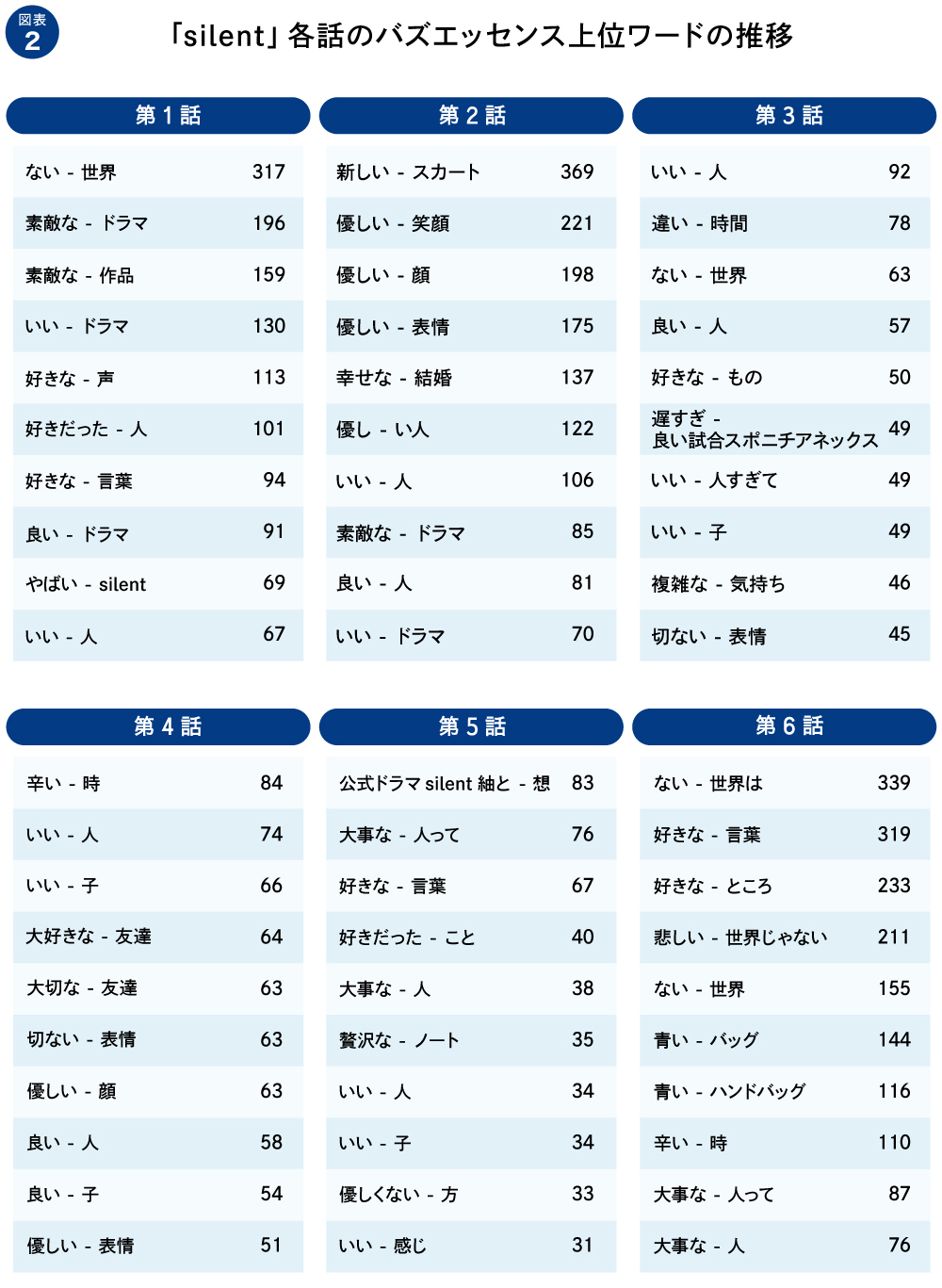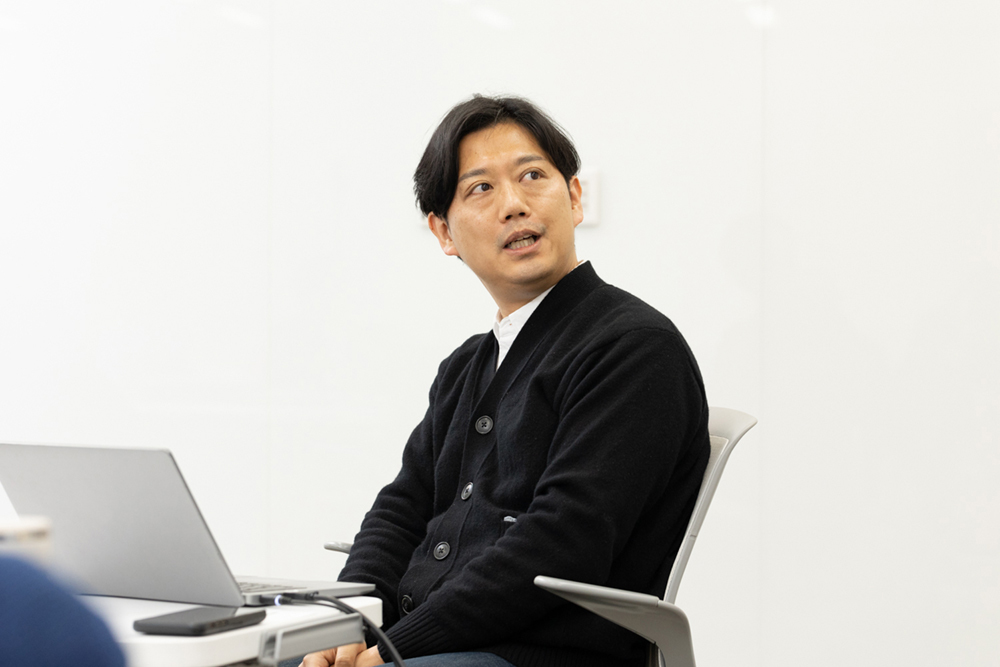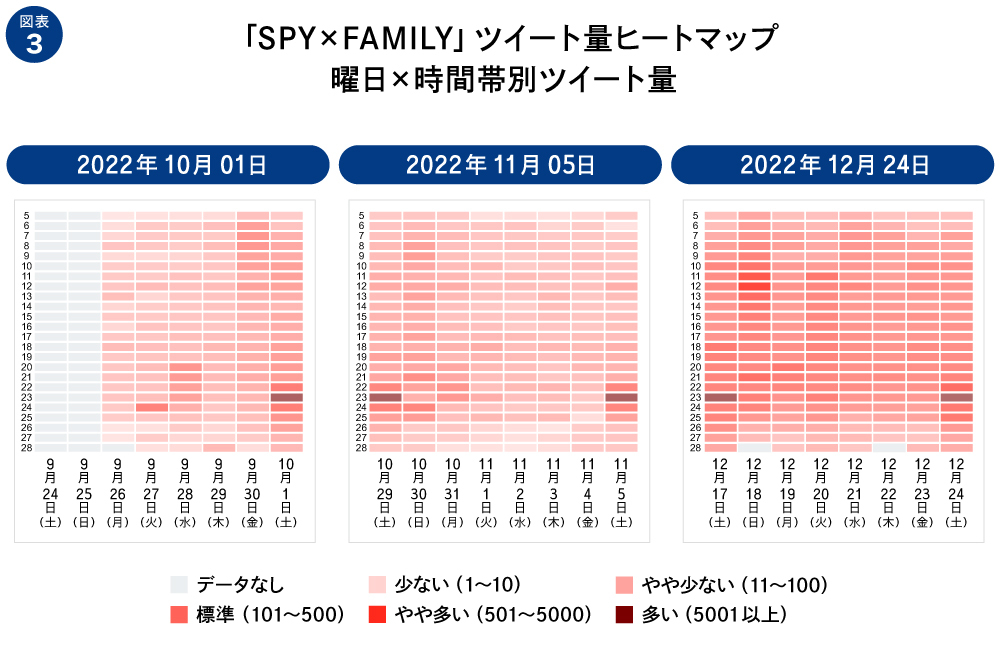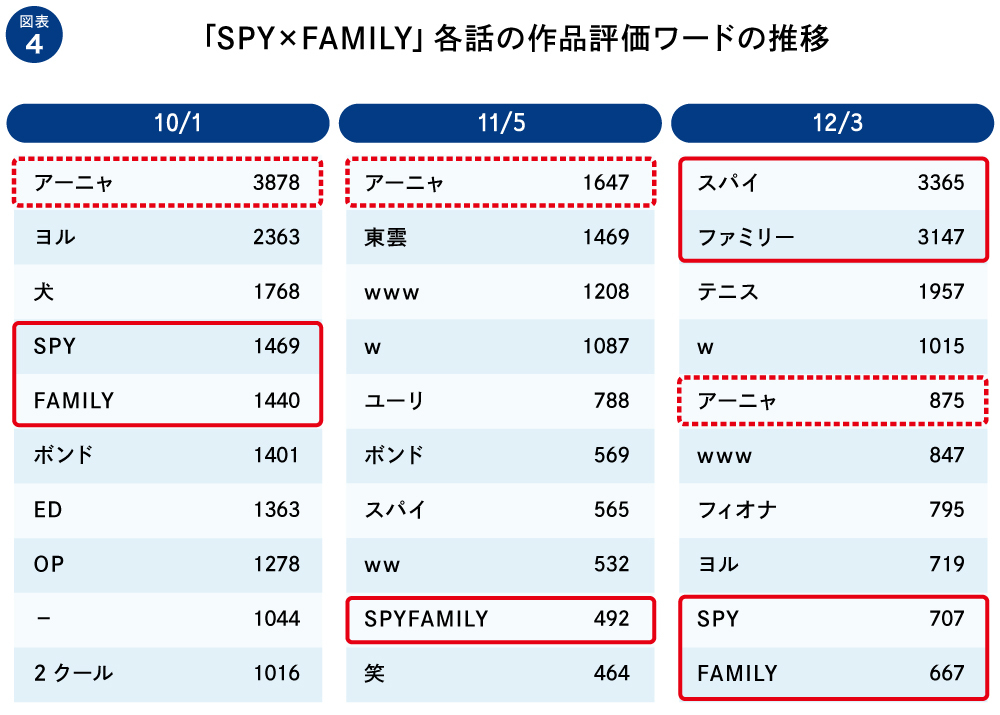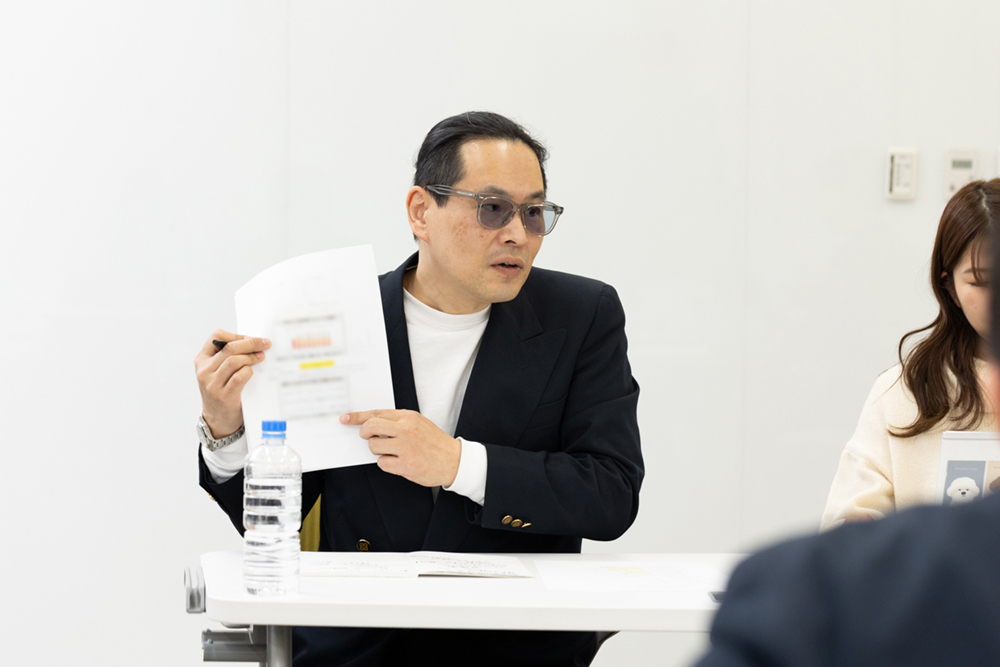
Four analyzed works ※"The 13 Lords of Kamakura" and "Elpis: Hope, or Disaster?" will be introduced
in Part 9 This series introduces the approach to consumer insights starting from "desire" and future developments by members of Dentsu Inc.'s new consumer research project, " DENTSU DESIRE DESIGN" (DDD).
The "FUKAYOMI" team (hereafter FUKAYOMI), a subcommittee of DDD, attempts to capture consumer insights and the budding seeds of values and desires likely to become mainstream in the future by deeply analyzing hit works that captivated many people.
Continuing from the previous installment, FUKAYOMI team members present their findings based on 'Buzz Viewun!' data regarding works that sparked buzz in 2022. Furthermore, incorporating insights from a different perspective by Hiroyuki Tanai of Dentsu Inc., a development collaborator for 'Buzz Viewun!', we unravel the viewer insights and desires behind the buzz.
※1=Buzz Viewn!
A survey system provided by Video Research Ltd. that monitors Twitter user reactions to TV programs in specific time slots in the Kanto region. It enables AI analysis of these posts across three dimensions: "Volume," "Quality," and "Audience Demographics." The service officially launched in April 2023 with technical support from Dentsu Inc.

Members who conducted the analysis. Back row, left to right: Taiyo Hamakubo, Hiroyuki Taniuchi. Front row, left to right: Yumi Ohno, Naofumi Sato, Masanobu Shiraishi, Toshiki Tanabe
"silent" isn't something you want to watch while multitasking or at double speed! The meticulous viewing attitude that created this unprecedented buzz

©️ Fuji Television
Hamakubo: Continuing from last time, I'd like to explore viewers' thoughts and behaviors in modern TV viewing by analyzing viewing trends for hit shows from the latter half of last year, and the expectations and emotional shifts they reveal. Now, let's examine "silent," which garnered attention in 2022 for both its ratings and buzz.
Ohno: I'm Ohno, in charge of "silent." This drama was already generating buzz before airing due to the collaboration between Haruna Kawaguchi and Ren Meguro. To briefly summarize the plot: A woman who was unilaterally dumped via LINE by her high school boyfriend after graduation unexpectedly reunites with him eight years later. He has completely lost his hearing due to a progressive illness. Though circumstances have changed, it's a love story about walking together again with him in a "world without sound."
Tweet volume during broadcasts was exceptionally high, averaging over 5,000 posts on airing Thursdays. While female viewers in their 20s overwhelmingly dominated, male viewers in their 20s were also significant, making it a show that captured the hearts of the younger generation. At the time of Episode 1, posts like "Go Meme (Meguro-san's nickname)!" and "Watching live!"—typically from idol fans—were the majority. However, by Episode 11, posts from general viewers had surpassed them. This shift shows that while the show initially gained attention due to its cast appeal, it steadily increased its audience through the story's inherent charm as episodes progressed.
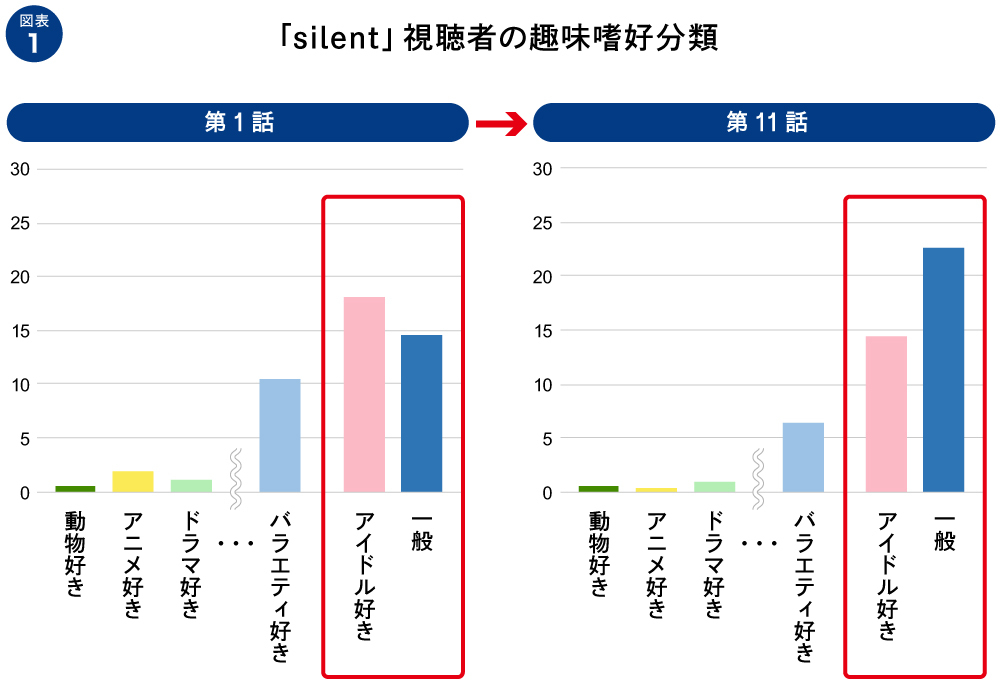
Ohno: Furthermore, analyzing the Buzz Essence (※2) revealed a major characteristic: across all episodes, buzz was generated using warm, positive words like "wonderful," "kind," "happy," and "important." While social satire and slander-driven buzz are common on Twitter, this kind of heartwarming buzz is rare. Many viewers likely found comfort in the phenomenon where Twitter became a warmer place solely after "silent" aired.
The final episode also saw numerous posts expressing gratitude towards the production team, offering a glimpse of the respect viewers felt for the creators who wrapped the world in such warmth.
※2=Buzz Essence
The "noun + adjective" combinations frequently used in posts about that program. They visualize what aspects of the show are being discussed and how it's being evaluated.
Taniuchi: Meguro-san became a topic in online columns about this drama for "performing sign language so authentically it's hard to believe she's an idol." This positive "subversion" or "breaking of expectations" likely contributed to its appeal. The production team's earnest effort to build the world and their clear dedication to the work probably resonated with viewers.
Ohno: I agree. This drama also stood out because it wasn't often watched casually or at double speed, which has become more common lately. It was watched attentively. Since conversations progressed using sign language, viewers had to watch carefully to understand what was happening, and the "pacing" of the acting was also valued. Furthermore, with various plot threads woven throughout, it likely fostered a desire to slowly digest and savor the depth of the work.
It was precisely this careful content and viewing attitude that fostered the warm buzz. I believe the desire to avoid tweeting carelessly about something you watched attentively led to more thoughtful language in posts.
This warm space on social media, where the work is cherished, resonated with modern desires.
Ohno: What I read from the "silent" buzz is that viewers craved "a longing for human warmth." Because SNS often breeds thoughtless words and conflict, making people feel unpleasant, this buzz likely made visible that underlying desire for warmth.
That said, a mere slice-of-life drama wouldn't have generated this level of buzz. The emotional resonance stemmed from tragedies like disability and misunderstandings. The way the story approached and depicted these situations with warmth created that "precious" feeling, sparking massive buzz.
Taniuchi: This show's buzz was on a completely different level. "silent" felt like it existed in its own dimension; it was undoubtedly the "Buzz King" of its season. Why it alone achieved such massive buzz was a huge mystery, but hearing Mr. Ohno's perspective made it click. This drama likely created its own "Guardians" (protectors of the work).
At its core, SNS is a space for human connection. It's a world where the desire to support others and the trust earned from individuals reign supreme. No matter how many followers you gain through gifts or high-impact campaigns, you won't earn the desire to "become part of the group" or genuine trust.
Precisely because we're so accustomed to a digital world flooded with immediate, superficial stimulation, there's a growing tendency to value "emotional" content. Approaches that make people feel they want to share something deeply cherished by someone else, or that they want to join the circle of people who cherish it, are incredibly effective. Those people become the "Guardians" who watch over the drama and support it with warm posts.
Hamakubo: Twitter tends to be a device for spreading negativity, but this work is a rare example that went in the opposite direction. The comment sections on online manga apps also tend to have more warm comments for heartwarming or feel-good stories. It shows there's a significant number of people enjoying that kind of pleasant world.
SPY×FAMILY: From Anya's "Meme-ification" to a "Constantly Trending" Work

©️Tatsuya Endo/Shueisha・SPY×FAMILY Production Committee
Hamakubo: Next, let's discuss "SPY×FAMILY."
Shiraishi: I'm Shiraishi, in charge of "SPY×FAMILY." This work is based on an extremely popular manga originally published in the manga app "Shonen Jump+." It was adapted into an anime in 2022, airing from April to June and October to December.
The story is set in the East-West Cold War era, featuring two nations: the Western country, Westeris, and the Eastern country, Ostania, engaged in covert information warfare. The protagonist is Lloyd Forger, a psychiatrist who is actually a highly skilled spy codenamed Twilight, sent from Westeris to Ostania. To gain access to a powerful politician in the East, he creates a fake family. He enrolls Anya, the girl playing his "daughter," into the prestigious school attended by the politician's son, Damian. In reality, Anya possesses the psychic ability to read others' minds, and Yoru, who plays his "wife," is actually an assassin. The three hide their true identities and abilities from each other.
In this work, each member forms a pseudo-family while harboring such secrets and missions, creating a robust structure substantial enough to craft a standalone story based on each individual's background. Additionally, the setting of the East-West Cold War era adds intrigue, and the balanced blend of genres like "Family," "Action," "Suspense," and "Comedy" further enhances its appeal.
Shiraishi: The reason this work gained even more buzz through its anime adaptation was due to Anya's character. While she was already a popular, adorable character in the original work, her charm exploded when color, voice, and movement were added in the anime. I believe the huge hit occurred after she went viral as a meme on social media.
※3=Meme
A cultural phenomenon where "jokes," funny images, or videos spread rapidly online through social media.
Analyzing the "Buzz View!" data during the anime's broadcast revealed two major shifts. First, while real-time live-tweeting dominated early on, posts shifted toward all-time coverage as the series progressed. Second, while posts initially focused on Anya's cuteness, they increasingly touched on the series' overarching themes as it advanced.
First, regarding the first change. Below is a heatmap showing the volume of tweets during the latter half of the anime's broadcast.
Shiraishi: Initially, the number of posts was high only during the broadcast time slot, with lighter colors elsewhere. However, by the final week, the color was consistently darker across the board, including daytime hours. This likely reflects the show becoming a regular topic of conversation and more people catching up via streaming services.
Taniuchi: Indeed, "SPY×FAMILY" was the undisputed king of social media cross-promotion throughout 2022. Though a terrestrial broadcast anime, it was available on numerous streaming platforms, and official character illustrations were continuously released. It buzzed across YouTube, Twitter, Instagram, and TikTok, creating a virtuous cycle where buzz generated more buzz and attracted more viewers.
The very nature of being a "fake family" resonated with viewers
Shiraishi: Regarding the shift in keywords reflecting changes in the work's reception, while "Anya" dominated the first half, the latter half centered more on the title itself. Posts mentioning points like "real families vs. fake families" also appeared frequently. Considering the underlying desires and social climate behind this shift, I feel the point that resonated with viewers was the family drama aspect using the "fake family" as a gimmick.
Shiraishi: The protagonists aren't biologically related, yet they act as a family and support each other. Ultimately, this makes them seem like an "ideal family." The question of "why these three unrelated people are connected" seemed to present the theme of "what truly defines a family."
In recent years, family values are rapidly changing due to factors like declining birthrates, an aging population, rising rates of unmarried individuals, and societal acceptance of same-sex marriage. While diversity is celebrated, no new role models are being presented, leaving people unsure of what the right answer is. Amidst a societal shift where the traditional "way of being a family" is fading, the desire to understand and feel what "family bonds" and "the value of being family" truly mean likely manifested in the buzz around "SPY×FAMILY."
Taniuchi: I see. Anya is an orphan with no family, right? So when Lloyd takes her in, she pretends to be smart to win his favor, but underlying that is the fear of "What if I get abandoned?" This feeling of "What if I get abandoned?" might just be a keyword for Generation Z.
Anya survives by clinging to something "like" a family. Today's Japan embraces diversity in family structures and marriage styles—single-parent households, same-sex marriages—celebrating the idea that all family forms are valid. Yet, eliminating "absolutes" also brings instability.
Employment practices, too, have lost "absolutes" like lifetime employment, making people vulnerable to being let go at any moment. While any family form is valid, finding a comfortable environment for yourself requires active pursuit. Amid this uncertainty and the anxiety of "What if I get discarded?", I feel a growing desire to simply meet good friends, regardless of formality, and live happily.
From now on, all TV programs will merge with SNS and media.
Sato: Looking at all four works, I believe the core of Twitter posts is undoubtedly "emotion." Through this analysis, we identified several concepts surrounding that core. While organizing these concepts, I'd like to summarize the correlation between the buzz of the analyzed works and these concepts here as a MAP. How about an image like the one below?
Sato: First, I organized the axes as follows:
- Vertical Axis: "Fast" – Tweeting/RTing in immediate reaction to the work's development or direction / "Slow" – Engaging in thoughtful, long-term discussion
- Horizontal Axis: "Meme" – Enjoying a single element extracted from the work; "Theme" – Deeply savoring the entire story
Within this framework, "The 13 Lords of Kamakura" (*4) generated emotion through gaps and intentionally incorporated memes to quickly drive posts and RTs. "Elpis: Hope, or Disaster" (*4) gradually shifted viewer interest from the thrill of uncovering the truth to delving into themes, leading to slower posting.
What made "silent" revolutionary was how its use of sign language and careful foreshadowing slowed viewer engagement, consequently slowing down posting activity. This movement, where viewer attitude determines the quality and quantity of posts, represents a significant discovery that could be leveraged in future drama production. Finally, "SPY×FAMILY" achieved overall success by using memes as an entry point while gradually shifting the focus towards its themes.
※4=For detailed analysis of "The 13 Lords of Kamakura" and "Elpis," refer here.
From this MAP, I believe there are two methods for generating buzz. One is to create content focused on a single point on the MAP. The other is to establish a foothold somewhere while gradually expanding the area. In the first case, it's easy to assume the upper "Fast" side of the MAP is more compatible with Twitter, but actually, there's potential on the "Slow" side. Creating content aimed there could spark long-lasting discussions among viewers or lead to posts that deeply explore the themes.
Hamakubo: That's certainly true. Also, as a general observation, I felt that "predictable outcomes" are generally not favored. "The 13 Lords of Kamakura" is a historical piece, so everyone knows the ending, but the way it was portrayed defied expectations and went viral. "SPY×FAMILY" also broke from the traditional family image, like that of Sazae-san, and many people were drawn to this different family dynamic. By defying predictable outcomes, viewers' emotions were stirred.
Sato: I reaffirm that a "hit (buzz)" is the "visualization of desire." In this era, what lies within our hearts becomes visible through Twitter. Twitter also functions as a mechanism where users see others' posts and realize, "I have the same desire." To create a hit, rather than just doing what "goes over well," it's becoming increasingly important to focus on creating insights, much like advertising.
Tanai: At Video Research Ltd., they seem to view ratings as indicating the "volume" of viewing, while "Buzz Viewun!" is a system that allows you to see the "quality" – the individuality and image of each program, and what specific points attract fans.
My sense is that television has already merged with SNS into a media mix. TV program producers can now distribute content not just through broadcast but also via SNS. Viewers, too, are driven by a desire to "connect," consuming content and relationships rather than just watching and moving on. Younger audiences, especially, excel at building "circles" on SNS and likely perceive TV programs as one such "circle."
For them, what matters is whether that program can become a "circle" that fulfills their desires. Is it a circle that satisfies "fast desires"—those that get excited by fleeting stimulation—or a circle that fulfills "guardian desires"—those that build lasting relationships? Either way, it's no longer just about the traditional approach of "broadcast on terrestrial TV and done." It's becoming crucial to anticipate and strategize which "circle" you want viewers to join.
We're now in an era where we design "how we want the program to be perceived on social media." For future program creators, the key will be expanding the "diversity of circles" and figuring out how to attract viewers who want to "have their say" or "participate."
Hamakubo: Exactly. Producers now create programs with SNS as a given, strategizing how to engage audiences. In that sense, we've entered an era where content creation doesn't end with the broadcast itself. The future of TV programming hinges on how effectively we stimulate and chain together people's desires.











